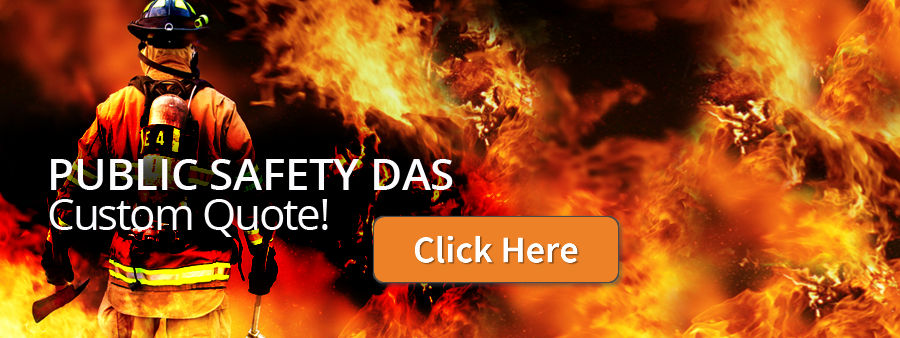Public Safety DAS ERCES / ERRC
Powerful Signal provides ERRC & ERCES solutions that meet NFPA & IFC building codes.
Do I need a public safety DAS?
Most U.S. states and cities now require new buildings—and in some cases existing buildings—to have an ERRC or ERCES public safety system in place before receiving a certificate of occupancy. The exact system requirements are determined by the local fire marshal or AHJ (Authority Having Jurisdiction); they are not standardized across all states, counties, or cities. Finding the right professional provider to help you navigate the process is critical to a successful installation of your public safety system.
With Powerful Signal’s exceptional experience, knowledge, service, support, and quick response time, we can assist you in making an informed decision that meets your budget and the standards and the regulations published by the IFC and NFPA
that are required by your AHJ.
What is public safety DAS?
A public safety system—also called an ERRC (Emergency Responder Radio Coverage) system—is a network of antennas that enable communication for police, firefighters, EMS, and other emergency responders inside your building. It’s a comprehensive framework designed to ensure that first-responder radios can communicate with command centers and each other during critical situations. These systems address a wide range of emergencies, including building fires, natural disasters, accidents, public health crises, and security threats, with the primary goals being to minimize response times, coordinate resources effectively, and communicate crucial information to the public and relevant authorities.
A public safety DAS (Distributed Antenna System)—also called an ERCES (Emergency Responder Communication Enhancement System)—is an in-building, first-responder radio network that allows emergency responder radios to work when building materials would otherwise interfere with or completely block radio transmissions.
Some of the required elements of a public safety DAS system include:
- UL 2524
/924
-rated RF amplification equipment
- NEMA 4 enclosures
- Lightning protection
- BBUs (Battery Backup Units)
- Systems alarm monitoring
For the ERCES system in your building to pass inspection by your AHJ, it must include all these features.
First responders depend on emergency responder radio coverage (ERRC) to quickly and safely manage fire, EMS, and police-response situations in large buildings. When lives are on the line, a high-performance public safety DAS system in your commercial or public building keeps emergency services personnel connected and capable.
Commercial DAS vs. Public Safety DAS
A public safety DAS system is not a replacement for a commercial cellular booster system; these systems operate separately and under different FCC guidelines. In new buildings, both commercial and public safety systems can be installed at the same time, saving you time and money.
Get Your FREE Custom Quote!
Benefits of public safety ERRC systems
- Swift response: Integration of real-time data and communication channels enables a rapid and coordinated response to emergencies.
- Compliance with safety standards: Our ERRC public safety systems align with local regulations and best practices for a secure and compliant solution.
- Improved situational awareness: GIS mapping and data analysis aid first responders by providing better understanding and visualization of the emergency situation.
- Enhanced public safety: Timely and accurate communication helps first responders make informed decisions, leading to safer outcomes during emergencies.
- Resource optimization: Efficient coordination among different agencies ensures optimal use of resources and minimizes duplication of efforts.
Powerful Signal provides Public Safety/ Emergency Responder Radio Communication Systems (ERCES) that meet the published requirements of your local Authority Having Jurisdiction (AHJ). Powerful Signal will provide customized design, engineering, installation, and optimization of a distributed antenna system in your building. Our best-in-class public safety team will ensure that your project complies with state and federal building codes, conduct the required wireless grid testing for meeting fire codes and ERRC connectivity standards, and provide assistance with permitting and fees as required by the AHJ.
Wireless grid testing is crucial for meeting fire codes and enhancing cellular connectivity in buildings. The test evaluates the need for systems like DAS, ERRC, or other boosters due to dead spots from building materials and RF interference in affected areas of the property. Powerful Signal provides expert grid testing services to assess and address connectivity needs quickly and effectively, ensuring improved wireless communication inside your building.
Our public safety team will also assist with submitting the package to the AHJ for permitting, licensing and any required fees.
What’s the difference between an ERRC and an ERCES?
Until recently, the terms ERRC and ERCES were used interchangeably; today, they’re separated into specific areas of a public safety system: ERRC (Emergency Responder Radio Coverage) refers to the actual radio frequency amplifier and the DAS (distributed antennas system) that provide signal coverage to required areas of the building. ERCES (Emergency Responder Communication Enhancement System) tends to be a more comprehensive approach involving speakers, intercoms, emergency sirens, and lighting, along with the bidirectional DAS system required in most jurisdictions. The main elements of an ERCES include:
- Speakers and microphones are used to transmit messages and alerts to people inside the building. They may be located in strategic locations, such as in hallways or near exits, to ensure that people can hear the messages clearly.
- Intercoms allow individuals to communicate directly with emergency responders or with a central control room. They may be located in strategic locations throughout the building or may be handheld devices that can be carried by emergency responders.
- Two-way radios allow emergency responders to communicate with each other and with a central control room. They may be used to coordinate an emergency response or to provide updates on an ongoing situation.
- Emergency sirens may be activated to alert people to potential dangers. The sirens are located throughout the building and may be triggered remotely by emergency responders.
- Emergency lighting may be activated to guide people to exits or to provide additional illumination in areas in which it is difficult for people to see due to smoke or a failure of the main lighting system.
Why choose Powerful Signal?
Our process involves the professional design and installation of a distributed antenna system (DAS) that will meet the requirements for your building to receive a certificate of occupancy as required by your local building codes.
Powerful Signal’s designs address the necessary areas to be covered, the structural composition of the building, and the lengths and resulting attenuation (signal loss) associated with the runs of cable that connect the components of the DAS. Our professional design process allows us to determine the correct amplification equipment needed to provide the necessary broadcast radius for each strategically placed antenna.
We maintain close business relationships with the top technology providers to ensure we’re using best-in-class equipment and are employing it the most efficient and cost-effective manner.
We excel in providing quick turnaround times and are normally able to get your system quoted, designed, shipped, and installed in a matter of weeks, not months.
We design public safety solutions to meet the requirements outlined by local Authorities Having Jurisdiction (AHJs) throughout the United States. A properly designed and implemented public safety system will produce 99% coverage in areas of “vital importance” as designated by the AHJ. A minimum signal strength of −95 dBm will be achieved, as required by the NFPA and the IFC.
ERRC system requirements
The National Fire Protection Association (NFPA) outlines standards and regulations for public safety DAS systems that ensure adequate emergency communications. A building must provide communications coverage as outlined by the International Fire Code (IFC) and regulations set in place by the local authority. The IFC requires that 95 percent coverage is needed throughout the building, and the NFPA dictates that 99 percent coverage is required in areas that your AHJ designates as of “vital importance.” These regulations must be met to meet the wireless communication needs of first-responder radios and phones.
Public safety system annual RF grid testing
Section 510.6.1 of the International Fire Code (IFC) requires that every Emergency Responder Radio Communication System (ERRCS) be inspected annually to ensure it is functioning properly and safely.
ERRC systems must be retested annually to ensure compliance with NFPA, IFC, and local AHJ code requirements. An annual inspection includes:
- Review technical information and on-site documentation
- Visually inspect the system to ensure all components are correctly installed
- Measure system coverage and conduct grid testing
- Verify equipment alarms
- Conduct backup battery tests
- Compile a compliance report with recommendations for any corrective actions
In addition to the mandated annual test, some situations require retesting. These include:
- If local authorities change their radio frequencies
- If local authorities update from an analog to a digital-based system
- New construction or environmental elements that cause significant signal interference
Certified technicians ensure every ERRCS complies with NFPA 1221, IFC Section 510, and other applicable AHJ regulations.
Your public safety system from Powerful Signal
Public Safety ERRC systems represent a significant step forward toward providing for the safety and well-being of communities during emergencies. By leveraging advanced technologies and fostering collaboration, these systems make it possible for first responders and the public to safely and quickly face challenging situations. As technology continues to advance, increasingly sophisticated and capable public safety ERRC systems will play a pivotal role in shaping the future of emergency response and communication.
Powerful Signal understands the challenges involved in determining what you need to be compliant with public safety regulations. We take the frustration out of of finding out how long it will take and how much it will cost to meet these requirements. We make it as simple as possible for you, while also informing you about any of the details you need or want to know. We’ve been designing and installing DAS systems nationwide since 2007, and our in-house team of experts can obtain all the information, permits, and code requirements for your property.
Please don’t hesitate to contact us with any questions you might have or for a free consultation and quote: 435-634-6800.


